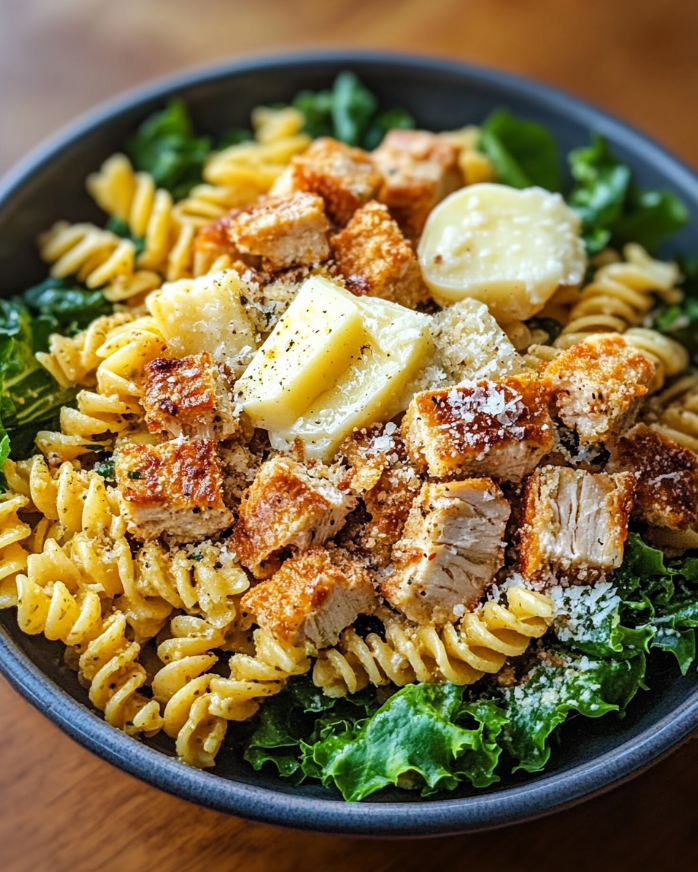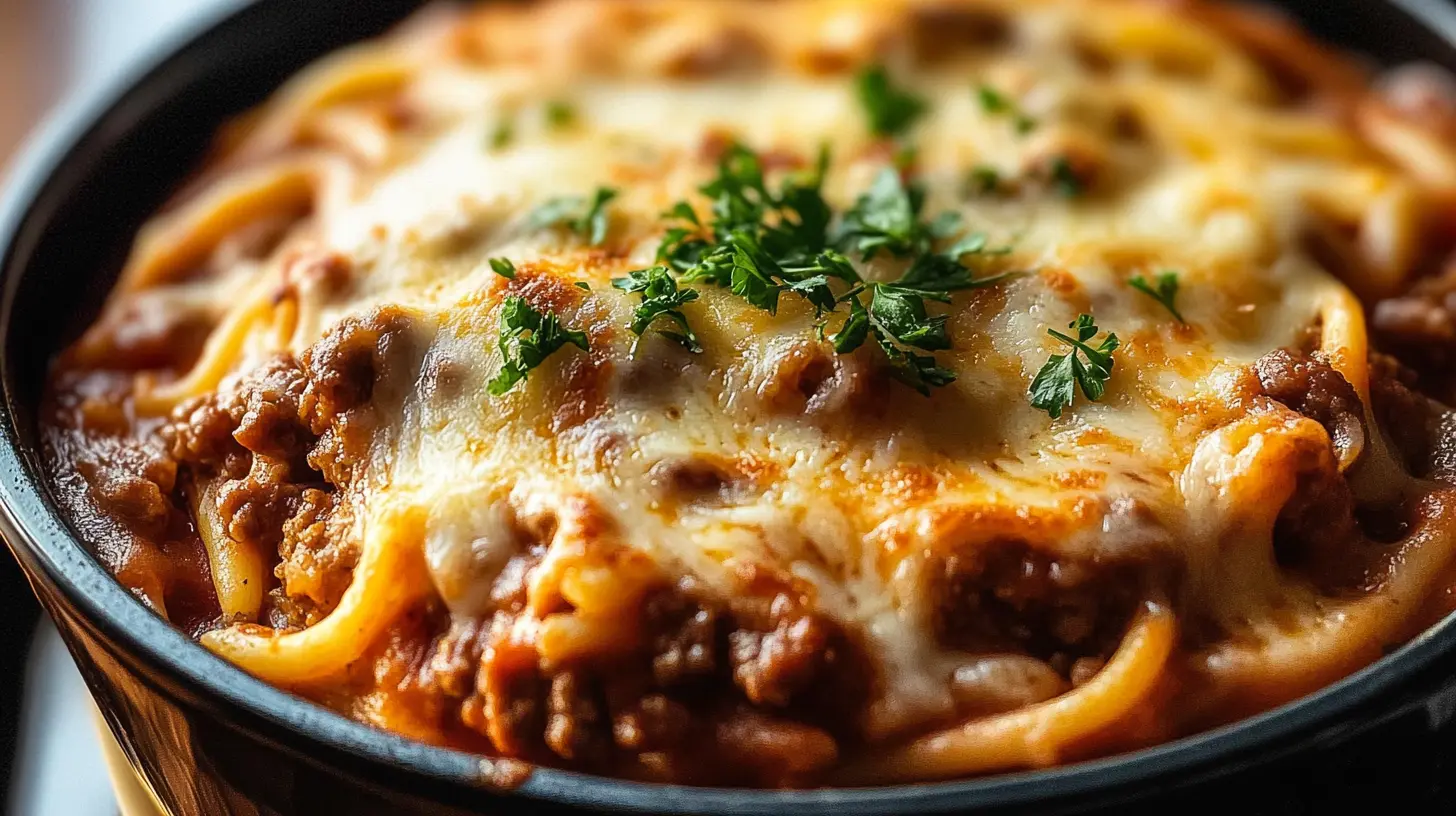Introduction to Caesar Pasta Salad
If you’re a fan of Caesar salad and pasta, why not combine the two into a delightful Caesar pasta salad? This dish blends the classic flavors of Caesar salad—think crisp romaine lettuce, tangy dressing, and Parmesan cheese—with the satisfying bite of pasta, creating a perfect balance between light and hearty. Ideal for busy parents, diet-conscious individuals, and food enthusiasts alike, this salad can easily be prepared in advance and enjoyed as a quick lunch or a refreshing dinner option. If you’re interested in more fusion dishes, you might also love our Cheesy Hot Beef Sandwich Recipe, which offers a comforting twist on another classic.
With its rich flavor profile and versatile ingredients, Caesar pasta salad is a dish that suits various dietary needs and preferences. It can be easily customized to accommodate vegan, gluten-free, or low-calorie diets, making it an inclusive option for gatherings and family meals. Additionally, its simple preparation and the availability of ingredients make it a go-to choice for those who want to enjoy a nutritious meal without spending hours in the kitchen.
Benefits and Advantages of Caesar Pasta Salad
Nutrient-Rich and Satisfying
Caesar pasta salad offers a satisfying meal that is rich in essential nutrients. By incorporating whole wheat pasta, fresh vegetables, and a protein source like chicken or chickpeas, you get a balanced mix of carbohydrates, fiber, protein, and healthy fats. The classic Caesar dressing, when made with ingredients like Greek yogurt or avocado, adds a creamy texture while boosting the salad’s nutritional value.
Quick and Easy to Prepare
One of the standout benefits of Caesar pasta salad is its ease of preparation. This dish requires minimal cooking, making it an excellent choice for those who have limited time. With pre-cooked or leftover pasta, the salad comes together in minutes. Plus, you can make a large batch and store it in the refrigerator for up to three days, ensuring you have a quick, healthy meal option ready to go.
Versatility for Different Dietary Needs
This salad is incredibly versatile, catering to various dietary requirements. For those following a gluten-free diet, simply use gluten-free pasta. If you’re looking for a lower-calorie option, substitute regular pasta with spiralized zucchini or cucumber. You can also make the dressing dairy-free by using a plant-based yogurt or omit the Parmesan for a vegan version. To explore more on how to adjust recipes to meet specific dietary needs, check out our article on Easy Keto Diet Shrimp.
Ingredients Overview
Essential Ingredients for Caesar Pasta Salad
To create a delicious Caesar pasta salad, you will need the following ingredients:
- Pasta: Use whole wheat or gluten-free pasta for added fiber and to accommodate dietary restrictions.
- Romaine Lettuce: Provides the classic crunch and freshness associated with Caesar salad.
- Parmesan Cheese: Adds a salty, umami flavor that complements the dressing.
- Caesar Dressing: Choose a store-bought option or make your own using Greek yogurt or avocado for a healthier twist.
- Croutons: For added crunch, use whole grain or gluten-free croutons.
- Protein: Chicken breast, chickpeas, or tofu are excellent options to increase the protein content.
- Lemon Juice: Adds acidity and brightens the overall flavor.
- Garlic: Provides a subtle spice and depth to the dressing.
- Olive Oil: Enhances the salad’s texture and flavor.
Dietary Substitutions to Customize Your Caesar Pasta Salad
Caesar pasta salad can easily be adapted to suit various dietary needs:
- Vegan: Replace Parmesan cheese with nutritional yeast and use a dairy-free Caesar dressing.
- Gluten-Free: Substitute traditional pasta with gluten-free pasta options and use gluten-free croutons.
- Low-Calorie: Opt for spiralized vegetables like zucchini or cucumber instead of pasta. Use a low-fat dressing made from Greek yogurt or a tahini-based dressing.
- High-Protein: Add grilled chicken, shrimp, or tofu for an extra protein boost. You could also incorporate chickpeas or lentils for plant-based protein.
How to Prepare the Perfect Caesar Pasta Salad: Step-by-Step Guide
Here’s a step-by-step guide to making a delicious Caesar pasta salad:
First Step: Prepare the Pasta and Vegetables
- Cook the Pasta: Boil water in a large pot and add a pinch of salt. Cook the pasta according to the package instructions until al dente. Drain and rinse under cold water to stop the cooking process and cool the pasta.
- Chop the Lettuce: While the pasta cooks, chop the romaine lettuce into bite-sized pieces. Wash and dry thoroughly to ensure it remains crisp in the salad.
Second Step: Make the Caesar Dressing
- Combine Ingredients: In a small bowl, mix Greek yogurt (or your preferred base) with minced garlic, lemon juice, Dijon mustard, olive oil, and a dash of Worcestershire sauce. Season with salt and pepper to taste.
- Blend Until Smooth: Use a whisk or a blender to combine all ingredients until the dressing is smooth and creamy.
Third Step: Assemble the Salad
- Mix the Ingredients: In a large bowl, combine the cooled pasta, chopped romaine lettuce, croutons, and Parmesan cheese.
- Add the Dressing: Pour the Caesar dressing over the salad and toss gently to coat all ingredients evenly.
Fourth Step: Add Protein and Extras
- Incorporate Protein: If adding protein, such as grilled chicken or chickpeas, do so at this stage. Ensure the protein is evenly distributed throughout the salad.
- Garnish and Serve: Garnish with additional Parmesan cheese, a sprinkle of fresh parsley, or a few slices of lemon. Serve immediately or refrigerate for up to three days.
Fifth Step: Customize Your Salad
- Try Different Add-Ins: Consider adding cherry tomatoes, red onions, or even olives for extra flavor and texture.
- Experiment with Dressings: Swap the Caesar dressing with a tahini-based or avocado-based dressing for a unique twist.
Mastering Caesar Pasta Salad: Advanced Tips and Variations
To elevate your Caesar pasta salad, consider these advanced tips and variations:
- Use Fresh Ingredients: Fresh romaine lettuce and high-quality Parmesan cheese enhance the overall flavor and texture of the salad.
- Prepare Homemade Croutons: For a personal touch, make your own croutons using whole grain bread, olive oil, and your favorite herbs.
- Add Roasted Vegetables: Roasted vegetables like bell peppers or asparagus add a smoky flavor and nutritional boost.
- Mix in Seasonal Fruits: For a sweet contrast, add seasonal fruits like grapes or apple slices.
- Create a Spicy Version: Add a dash of hot sauce or red pepper flakes to the dressing for a spicy kick.
How to Store Caesar Pasta Salad: Best Practices
To keep your Caesar pasta salad fresh:
- Refrigeration: Store in an airtight container in the refrigerator for up to three days. Keep the dressing separate if you plan to store the salad for more than a day to prevent the lettuce from wilting.
- Freezing: While it’s not ideal to freeze Caesar pasta salad due to the lettuce and dressing, you can freeze cooked pasta and protein separately. Thaw them and assemble the salad when ready to eat.
- Reheating: If using grilled chicken or another protein, you can gently reheat it on the stove or in the microwave before adding it to the salad.
Nutritional Value of Caesar Pasta Salad
Understanding the nutritional profile of Caesar pasta salad helps in maintaining a balanced diet:
- Calories: A typical serving ranges from 300-400 calories, depending on the ingredients.
- Protein: Provides around 15-20 grams of protein, especially with added chicken or chickpeas.
- Carbohydrates: Contains about 30-40 grams of carbs from pasta and vegetables.
- Fat: Offers healthy fats, especially if using olive oil and avocado in the dressing.
- Fiber: Offers 5-8 grams of fiber per serving, contributing to digestive health.
For a deeper dive into the health benefits of salads, consider reading our Sourdough Sandwich Bread Benefits & Recipe Tips, which offers complementary insights into nutritious meal planning.
FAQs: Frequently Asked Questions About Caesar Pasta Salad
Can I Make Caesar Pasta Salad Ahead of Time?
Yes, you can prepare Caesar pasta salad ahead of time. However, it is best to keep the dressing separate until just before serving to prevent the lettuce from becoming soggy.
What Types of Pasta Work Best for Caesar Pasta Salad?
Short pasta varieties like fusilli, penne, or bowties are ideal for Caesar pasta salad because they hold the dressing well and mix easily with other ingredients.
Is Caesar Pasta Salad Healthy?
Yes, when made with whole ingredients and a healthy dressing, Caesar pasta salad can be a nutritious meal. It provides a good balance of carbohydrates, protein, and fats, especially when using whole wheat pasta and adding a protein source like chicken or chickpeas.
Can I Make the Dressing Dairy-Free?
Absolutely! To make the dressing dairy-free, use a plant-based yogurt or a blend of avocado and olive oil. Nutritional yeast can replace Parmesan cheese for a cheesy flavor without the dairy.
What Should I Serve with Caesar Pasta Salad?
Caesar pasta salad pairs well with grilled meats, roasted vegetables, or even a warm soup. It can also be served as a main dish on its own for a light yet filling meal.
For more creative and healthy meal ideas, don’t miss our Alkaline Diet Recipes, which offer additional options for those looking to diversify their diet.
Is Caesar salad an Italian salad?
No, Caesar salad is not an Italian salad. Despite its name, Caesar salad was actually invented in Tijuana, Mexico, by an Italian-American restaurateur named Caesar Cardini in the 1920s. The salad gained popularity in the United States and has since become a staple in American cuisine, often associated with Italian flavors due to its ingredients like Parmesan cheese and garlic.
What is Caesar salad sauce made of?
Caesar salad sauce, also known as Caesar dressing, typically includes a blend of the following ingredients:
- Olive oil
- Lemon juice
- Egg yolk
- Dijon mustard
- Worcestershire sauce
- Garlic
- Parmesan cheese
- Anchovies (optional, but traditional for authentic flavor)
This dressing is creamy, tangy, and savory, offering a rich flavor that complements the crisp lettuce and other ingredients in the salad.
What does Caesar salad taste like?
Caesar salad has a distinctive taste characterized by a combination of savory, tangy, and creamy flavors. The dressing provides a rich and tangy taste with hints of garlic, lemon, and anchovies, while the Parmesan cheese adds a salty, umami flavor. The croutons contribute a satisfying crunch, making the overall texture both creamy and crispy.
What to serve with Caesar salad?
Caesar salad pairs well with a variety of dishes, including:
- Grilled Chicken: Adds protein and makes the salad a more filling meal.
- Seafood: Shrimp or salmon are great options that complement the flavors of Caesar salad.
- Soup: A light soup, such as minestrone or tomato basil, can balance the richness of the salad.
- Pasta: Light pasta dishes, such as spaghetti aglio e olio, are also excellent companions.
- Garlic Bread: Enhances the meal with an additional crunchy and savory element.
Is Caesar salad an American thing?
Yes, Caesar salad is considered an American thing, although it was created by an Italian-American in Mexico. It gained popularity in the United States and has since become a classic dish in American cuisine, particularly in restaurants and diners.
Is Caesar salad European?
While Caesar salad has ingredients commonly associated with European (especially Italian) cuisine, it is not European in origin. The salad was created in Tijuana, Mexico, by an Italian-American chef and has since become popular worldwide, especially in North America.
Is Caesar salad actually healthy?
Caesar salad can be a healthy option, depending on the ingredients and portion sizes. The traditional dressing is high in fat due to the use of egg yolk, oil, and Parmesan cheese. However, by making modifications—such as using a yogurt-based dressing, adding lean protein, and including plenty of fresh vegetables—you can create a healthier version that is rich in vitamins, protein, and healthy fats.
Did Romans eat Caesar salad?
No, Romans did not eat Caesar salad. The dish was named after Caesar Cardini, the chef who created it in the 20th century, not Julius Caesar of ancient Rome. There is no historical connection between the salad and Roman cuisine. For more information about the history of Caesar salad, you can visit Wikipedia’s page on Caesar Salad.
Is Caesar salad warm or cold?
Caesar salad is traditionally served cold. The crisp romaine lettuce and chilled dressing provide a refreshing contrast, especially when paired with warm proteins like grilled chicken.
Does Caesar salad contain mayonnaise?
Traditional Caesar salad dressing does not contain mayonnaise. Instead, it uses raw egg yolk to achieve a creamy texture. However, some modern recipes substitute mayonnaise for egg yolk to simplify the preparation and avoid the use of raw eggs.
Why does Caesar dressing have anchovies?
Anchovies are a traditional ingredient in Caesar dressing because they provide a unique umami flavor that enhances the overall taste. While not everyone includes anchovies in their Caesar salad dressing, they are considered a key component of the authentic recipe.
Is Caesar salad keto friendly?
Caesar salad can be keto-friendly if prepared with keto-approved ingredients. The traditional dressing is low in carbohydrates, but the croutons are not keto-compliant. To make a keto-friendly Caesar salad, omit the croutons and use a dressing without added sugars. Adding grilled chicken or shrimp can also increase the protein and fat content, making it suitable for a ketogenic diet.
Is Caesar salad a carb or protein?
Caesar salad primarily consists of low-carb ingredients like lettuce, cheese, and protein (chicken or shrimp), but the salad itself is not categorized strictly as either a carb or protein. The inclusion of croutons adds some carbohydrates, while the chicken or other proteins contribute to the protein content. The salad offers a balanced mix of both macronutrients.
Can you eat Caesar salad when pregnant?
Yes, pregnant women can eat Caesar salad, but they should ensure the dressing does not contain raw egg yolk due to the risk of salmonella. Many store-bought dressings use pasteurized eggs, which are safe for pregnant women. Alternatively, use a dressing made with mayonnaise or yogurt to avoid raw eggs entirely.
Can diabetics eat Caesar salad?
Yes, diabetics can eat Caesar salad, especially if it is prepared with low-carb ingredients. By avoiding croutons and choosing a dressing with no added sugar, diabetics can enjoy Caesar salad without significantly impacting their blood sugar levels. Including proteins like chicken or tofu can further balance the meal, making it suitable for a diabetic diet.
Conclusion:
Incorporating Caesar pasta salad into your meal rotation offers a delicious and versatile option that can cater to various tastes and dietary needs. This recipe combines the classic flavors of Caesar salad with the satisfying texture of pasta, creating a dish that is both easy to prepare and packed with nutrients. Whether you’re making it for a family dinner or a potluck, Caesar pasta salad is sure to be a hit. So, gather your ingredients, get creative with your add-ins, and enjoy a tasty, balanced meal today!

Posted by: Hailee | November 19, 2024
I’m passionate about sharing sweet and savory recipes that I’ve meticulously tested and perfected in my own kitchen. Join me on this delicious journey to experience the best of culinary creativity.




